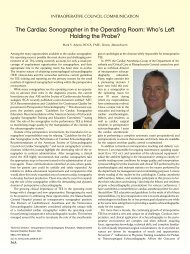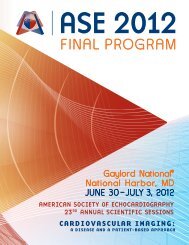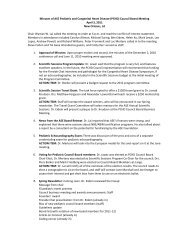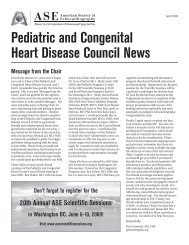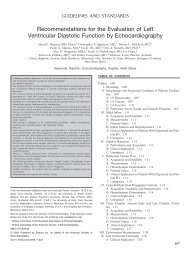Guidelines for the Echocardiographic Assessment of the Right Heart ...
Guidelines for the Echocardiographic Assessment of the Right Heart ...
Guidelines for the Echocardiographic Assessment of the Right Heart ...
Create successful ePaper yourself
Turn your PDF publications into a flip-book with our unique Google optimized e-Paper software.
686 Rudski et al Journal <strong>of</strong> <strong>the</strong> American Society <strong>of</strong> Echocardiography<br />
July 2010<br />
TABLE OF CONTENTS<br />
Executive Summary 686<br />
Overview 688<br />
Methodology in <strong>the</strong> Establishment <strong>of</strong> Reference Value and<br />
Ranges 688<br />
Acoustic Windows and <strong>Echocardiographic</strong> Views <strong>of</strong> <strong>the</strong> <strong>Right</strong><br />
<strong>Heart</strong> 690<br />
Nomenclature <strong>of</strong> <strong>Right</strong> <strong>Heart</strong> Segments and Coronary Supply 690<br />
Conventional Two-Dimensional <strong>Assessment</strong> <strong>of</strong> <strong>the</strong> <strong>Right</strong><br />
<strong>Heart</strong> 690<br />
A. <strong>Right</strong> Atrium 690<br />
RA Pressure 691<br />
B. <strong>Right</strong> Ventricle 692<br />
RV Wall Thickness 692<br />
RV Linear Dimensions 693<br />
C. RVOT 694<br />
Fractional Area Change and Volumetric <strong>Assessment</strong> <strong>of</strong> <strong>the</strong> <strong>Right</strong><br />
Ventricle 696<br />
A. RVArea and FAC 696<br />
B. Two-Dimensional Volume and EF Estimation 696<br />
C. Three-Dimensional Volume Estimation 697<br />
The <strong>Right</strong> Ventricle and Interventricular Septal Morphology 697<br />
A. Differential Timing <strong>of</strong> Geometric Distortion in RV Pressure and<br />
Volume Overload States 698<br />
Hemodynamic <strong>Assessment</strong> <strong>of</strong> <strong>the</strong> <strong>Right</strong> Ventricle and Pulmonary<br />
Circulation 698<br />
A. Systolic Pulmonary Artery Pressure 698<br />
B. PA Diastolic Pressure 699<br />
C. Mean PA Pressure 699<br />
D. Pulmonary Vascular Resistance 699<br />
E. Measurement <strong>of</strong> PA Pressure During Exercise 699<br />
Nonvolumetric <strong>Assessment</strong> <strong>of</strong> <strong>Right</strong> Ventricular Function 700<br />
A. Global <strong>Assessment</strong> <strong>of</strong> RV Systolic Function 700<br />
RV dP/dt 700<br />
RIMP 700<br />
B. Regional <strong>Assessment</strong> <strong>of</strong> RV Systolic Function 701<br />
TAPSE or Tricuspid Annular Motion (TAM) 701<br />
Doppler Tissue Imaging 702<br />
Myocardial Acceleration During Isovolumic Contraction 703<br />
Regional RV Strain and Strain Rate 704<br />
Two-Dimensional Strain 705<br />
Summary <strong>of</strong> Recommendations <strong>for</strong> <strong>the</strong> <strong>Assessment</strong> <strong>of</strong> <strong>Right</strong><br />
Ventricular Systolic Function 705<br />
<strong>Right</strong> Ventricular Diastolic Function 705<br />
A. RV Diastolic Dysfunction 705<br />
B. Measurement <strong>of</strong> RV Diastolic Function 705<br />
C. Effects <strong>of</strong> Age, Respiration, <strong>Heart</strong> Rate, and Loading Conditions<br />
706<br />
D. Clinical Relevance 706<br />
Clinical and Prognostic Significance <strong>of</strong> <strong>Right</strong> Ventricular <strong>Assessment</strong><br />
706<br />
References 708<br />
EXECUTIVE SUMMARY<br />
The right ventricle plays an important role in <strong>the</strong> morbidity and mortality<br />
<strong>of</strong> patients presenting with signs and symptoms <strong>of</strong> cardiopulmonary<br />
disease. However, <strong>the</strong> systematic assessment <strong>of</strong> right heart<br />
function is not uni<strong>for</strong>mly carried out. This is due partly to <strong>the</strong> enormous<br />
attention given to <strong>the</strong> evaluation <strong>of</strong> <strong>the</strong> left heart, a lack <strong>of</strong> familiarity<br />
with ultrasound techniques that can be used in imaging <strong>the</strong> right<br />
heart, and a paucity <strong>of</strong> ultrasound studies providing normal reference<br />
values <strong>of</strong> right heart size and function.<br />
In all studies, <strong>the</strong> sonographer and physician should examine<br />
<strong>the</strong> right heart using multiple acoustic windows,<br />
and <strong>the</strong> report should represent an assessment based on<br />
qualitative and quantitative parameters. The parameters<br />
to be per<strong>for</strong>med and reported should include a measure<br />
<strong>of</strong> right ventricular (RV) size, right atrial (RA) size, RV systolic<br />
function (at least one <strong>of</strong> <strong>the</strong> following: fractional area<br />
change [FAC], S 0 , and tricuspid annular plane systolic excursion<br />
[TAPSE]; with or without RV index <strong>of</strong> myocardial<br />
per<strong>for</strong>mance [RIMP]), and systolic pulmonary artery (PA)<br />
pressure (SPAP) with estimate <strong>of</strong> RA pressure on <strong>the</strong> basis<br />
<strong>of</strong> inferior vena cava (IVC) size and collapse. In many conditions,<br />
additional measures such as PA diastolic pressure<br />
(PADP) and an assessment <strong>of</strong> RV diastolic function are indicated.<br />
The reference values <strong>for</strong> <strong>the</strong>se recommended measurements<br />
are displayed in Table 1. These reference values<br />
are based on values obtained from normal individuals<br />
without any histories <strong>of</strong> heart disease and exclude those<br />
with histories <strong>of</strong> congenital heart disease. Many <strong>of</strong> <strong>the</strong> recommended<br />
values differ from those published in <strong>the</strong> previous<br />
recommendations <strong>for</strong> chamber quantification <strong>of</strong> <strong>the</strong><br />
American Society <strong>of</strong> Echocardiography (ASE). The current<br />
values are based on larger populations or pooled values<br />
from several studies, while several previous normal values<br />
were based on a single study. It is important <strong>for</strong> <strong>the</strong> interpreting<br />
physician to recognize that <strong>the</strong> values proposed<br />
are not indexed to body surface area or height. As a result,<br />
it is possible that patients at ei<strong>the</strong>r extreme may be misclassified<br />
as having values outside <strong>the</strong> reference ranges. The<br />
available data are insufficient <strong>for</strong> <strong>the</strong> classification <strong>of</strong> <strong>the</strong><br />
abnormal categories into mild, moderate, and severe.<br />
Interpreters should <strong>the</strong>re<strong>for</strong>e use <strong>the</strong>ir judgment in determining<br />
<strong>the</strong> extent <strong>of</strong> abnormality observed <strong>for</strong> any given<br />
parameter. As in all studies, it is <strong>the</strong>re<strong>for</strong>e critical that all in<strong>for</strong>mation<br />
obtained from <strong>the</strong> echocardiographic examination<br />
be considered in <strong>the</strong> final interpretation.<br />
Essential Imaging Windows and Views<br />
Apical 4-chamber, modified apical 4-chamber, left parasternal longaxis<br />
(PLAX) and parasternal short-axis (PSAX), left parasternal RV<br />
inflow, and subcostal views provide images <strong>for</strong> <strong>the</strong> comprehensive assessment<br />
<strong>of</strong> RV systolic and diastolic function and RV systolic pressure<br />
(RVSP).<br />
<strong>Right</strong> <strong>Heart</strong> Dimensions. RV DIMENSION. RV dimension is best estimated<br />
at end-diastole from a right ventricle–focused apical 4-chamber<br />
view. Care should be taken to obtain <strong>the</strong> image demonstrating <strong>the</strong><br />
maximum diameter <strong>of</strong> <strong>the</strong> right ventricle without <strong>for</strong>eshortening<br />
(Figure 6). This can be accomplished by making sure that <strong>the</strong> crux<br />
and apex <strong>of</strong> <strong>the</strong> heart are in view (Figure 7). Diameter > 42 mm<br />
at <strong>the</strong> base and > 35 mm at <strong>the</strong> mid level indicates RV<br />
dilatation. Similarly, longitudinal dimension > 86 mm<br />
indicates RV enlargement.<br />
RA DIMENSION. The apical 4-chamber view allows estimation <strong>of</strong> <strong>the</strong><br />
RA dimensions (Figure 3). RA area > 18 cm 2 , RA length<br />
(referred to as <strong>the</strong> major dimension) > 53 mm, and RA diameter<br />
(o<strong>the</strong>rwise known as <strong>the</strong> minor dimension) > 44<br />
mm indicate at end-diastole RA enlargement.



